The Art of World War One in 52 Paintings #2 (Rare Collection)
Since the First World War was fought at a time of major changes in artistic movements, the period is particularly rich with a variety of art styles. The development of photography in the late 19th Century had pushed painting particularly away from realism, into a broad group called expressionism. The movement sought to present the world subjectively, radically distorting it for emotional effect – famous artists such as Edvard Munch, Paul Klee and Wassilly Kandinsky were all expressionists.
The effect of the movement meeting the cataclysm of the war saw expressionist painting directly related to the fighting appear across Europe. In Britain, some of the more prominent works related to the war abandoned realistic styles and combined with the trend of Italian Futurism and Cubism to create Vorticism. Industrial warfare, shattered landscapes and the horrors of the battlefield suited modernist styles, and art often escaped earlier realism.
Realism and the First World War
While realism was abandoned by some artists – particularly after the horrors at the Battle of The Somme – it did endure the course of the war. A notable war artist of the period prior to the war was Richard Caton Woodville, who had regular commissions for the Illustrated London News. His works on British conflicts in Afghanistan and The Boer War evoked a sense of drama, thrill and patriotic exultation which continued to be used in World War One by British artists.
Realism and the First World War
While realism was abandoned by some artists – particularly after the horrors at the Battle of The Somme – it did endure the course of the war. A notable war artist of the period prior to the war was Richard Caton Woodville, who had regular commissions for the Illustrated London News. His works on British conflicts in Afghanistan and The Boer War evoked a sense of drama, thrill and patriotic exultation which continued to be used in World War One by British artists.
Charge of the Light Bridge (Left, 1894) & Maiwand: Saving the Guns (Right, 1884) by Richard Caton Woodville

This romantic vision of war had dominated the British interpretation of Imperial conflict. Scenes involving cavalry were regularly painted, but by 1916 this subject matter was almost entirely obsolete.
Canadians at Ypres by William Barnes-Wollen (1915)
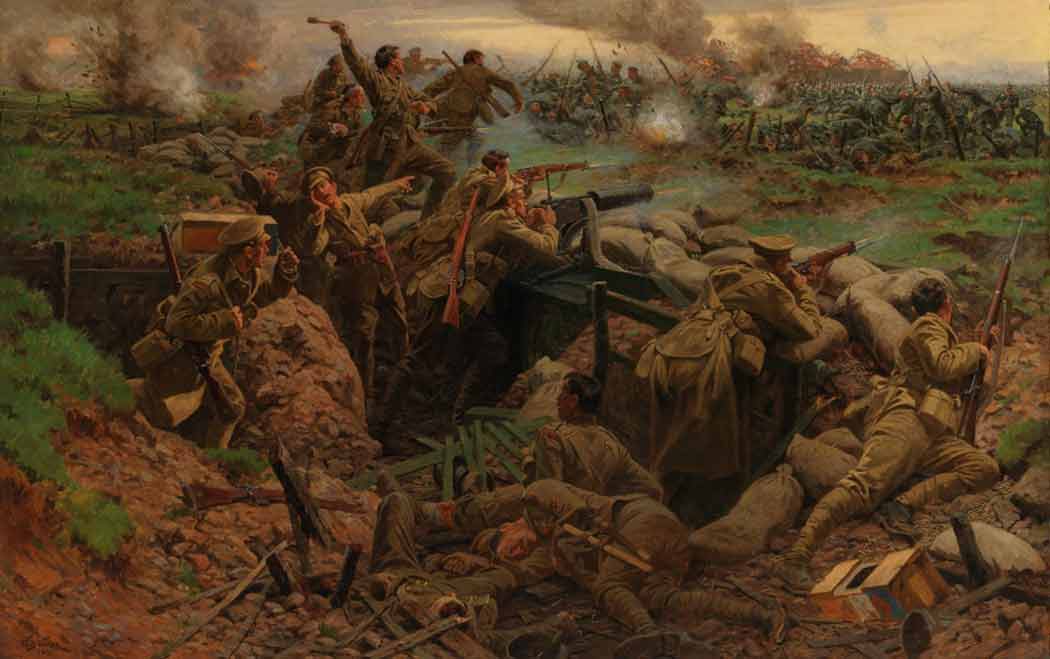
Here the realistic, illustrative style remains – although the war’s destructiveness is still being realised.
Second Lieutenant W. H. G. Jessup, Duke of Cornwall’s Light Infantry, on the Western Front (Left) and Winning the Military Cross during the Battle of the Somme (Right) by Stanley Llewelyn Wood (Both 1916)
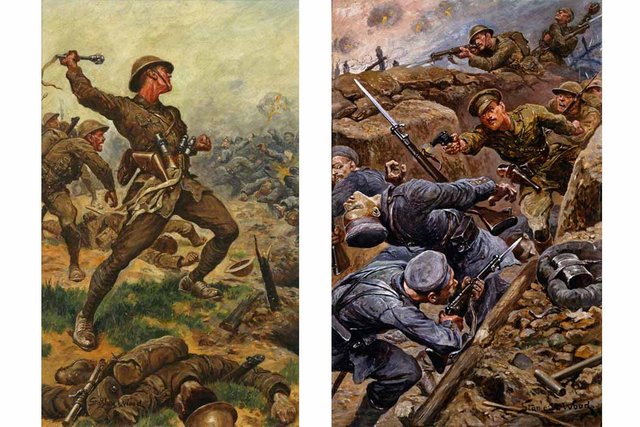
Futurism and Vorticism
Futurism emphasised and glorified themes associated with the future – such as speed, technology and violence. Emanating from Italy, the movement influenced a number of British artists – particularly CRW Nevinson and the Vorticists.
Charge Of The Lancers by Umberto Boccioni (1915)
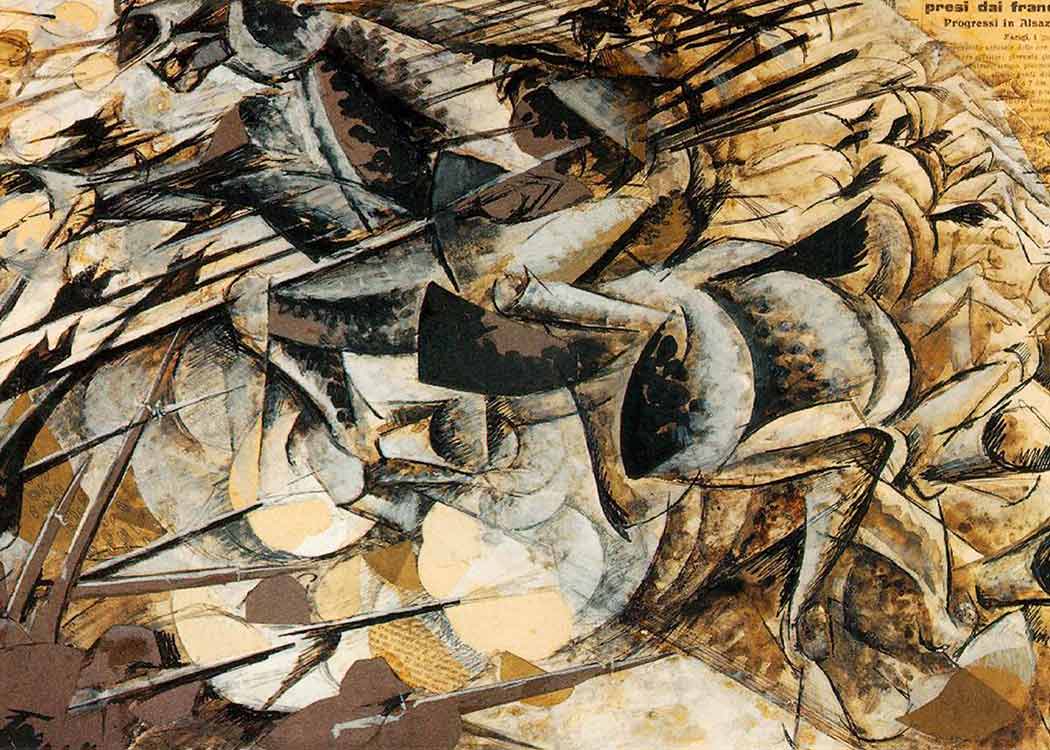
‘If futurism embraced the present, it also rejected the past.’ Umberto Boccioni was one of those who iconoclastically attacked the remote, 19th century Mediterranean art tradition by vividly realizing the shrill, dynamic realities of the present conflict.
Study for Returning To The Trenches by CRW Nevinson (1914)
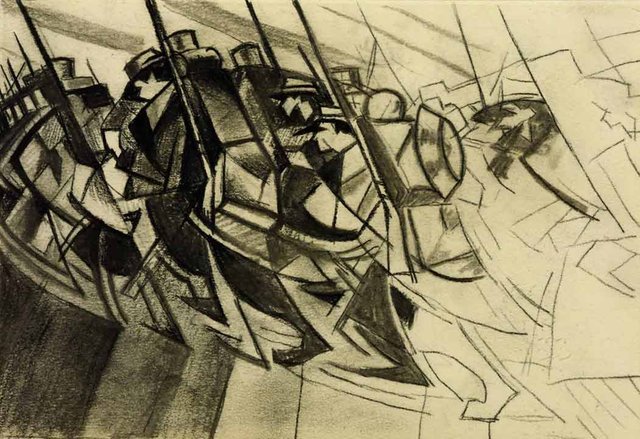
Nevinson said of this piece ‘I have tried to express the emotion produced by the apparent ugliness and dullness of modern warfare. Our Futurist technique is the only possible medium to express the crudeness, violence and brutality of the emotions seen and felt on the present battlefields of Europe.’
Study for Sappers at Work by David Bomberg (1919)
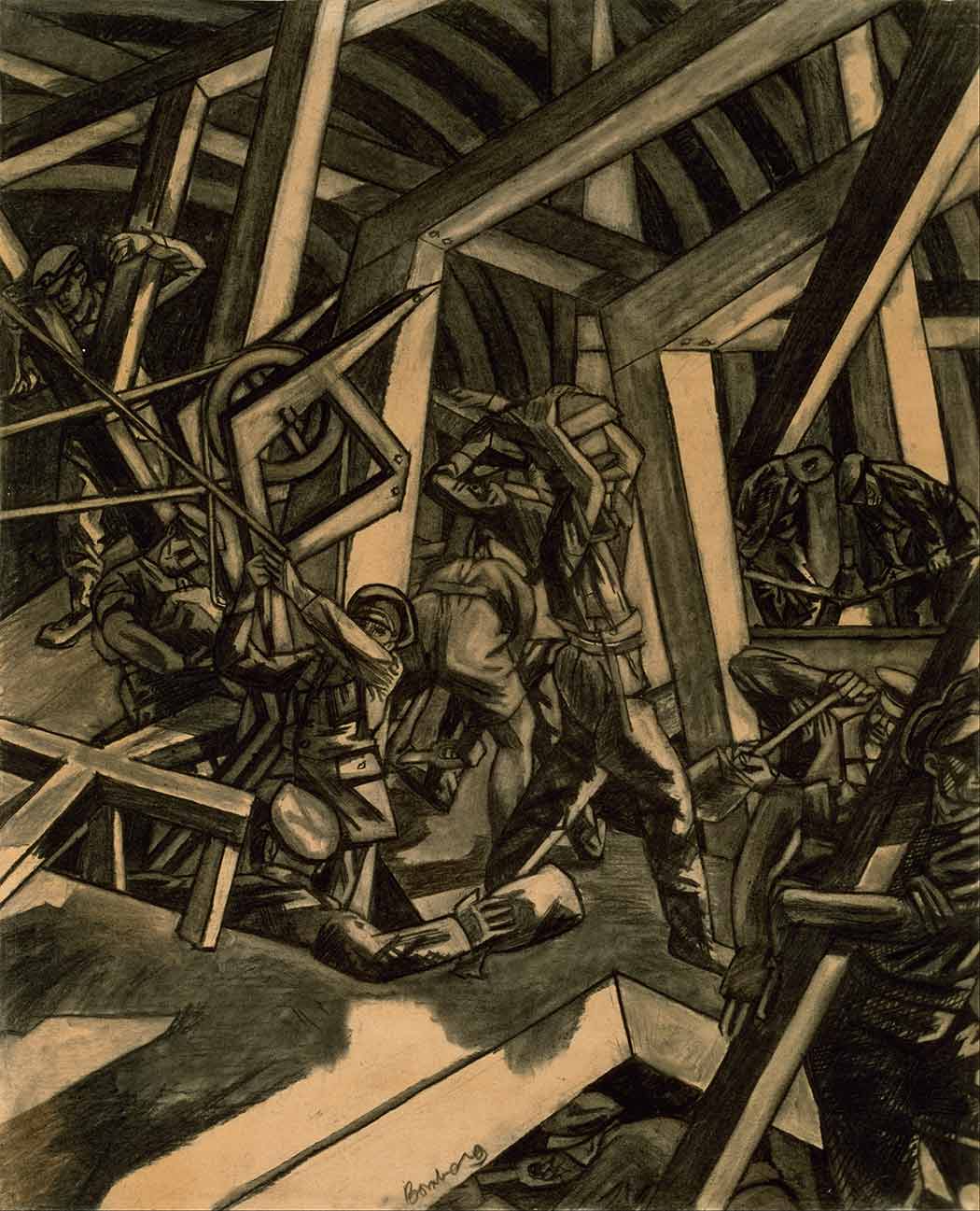
Bomberg’s piece commemorates an incident when a company of Canadian sappers laid mines under German trenches. It was criticised as a ‘Futurist abortion’ on its creation when Bomberg had in fact mellowed his radical abstract instincts to cultivate a more representative style.
Battery Shelled by Percy Wyndham Lewis (1919)

Wyndham Lewis conveys the effects of counter-battery artillery fire. The painting is suffused with Lewis’ trademark Vorticist style, and the contrast between the detached soldiers in the foreground and the animated gunners in the rear has attracted critical interest.
La Mitrailleuse by CRW Nevinson (1915)
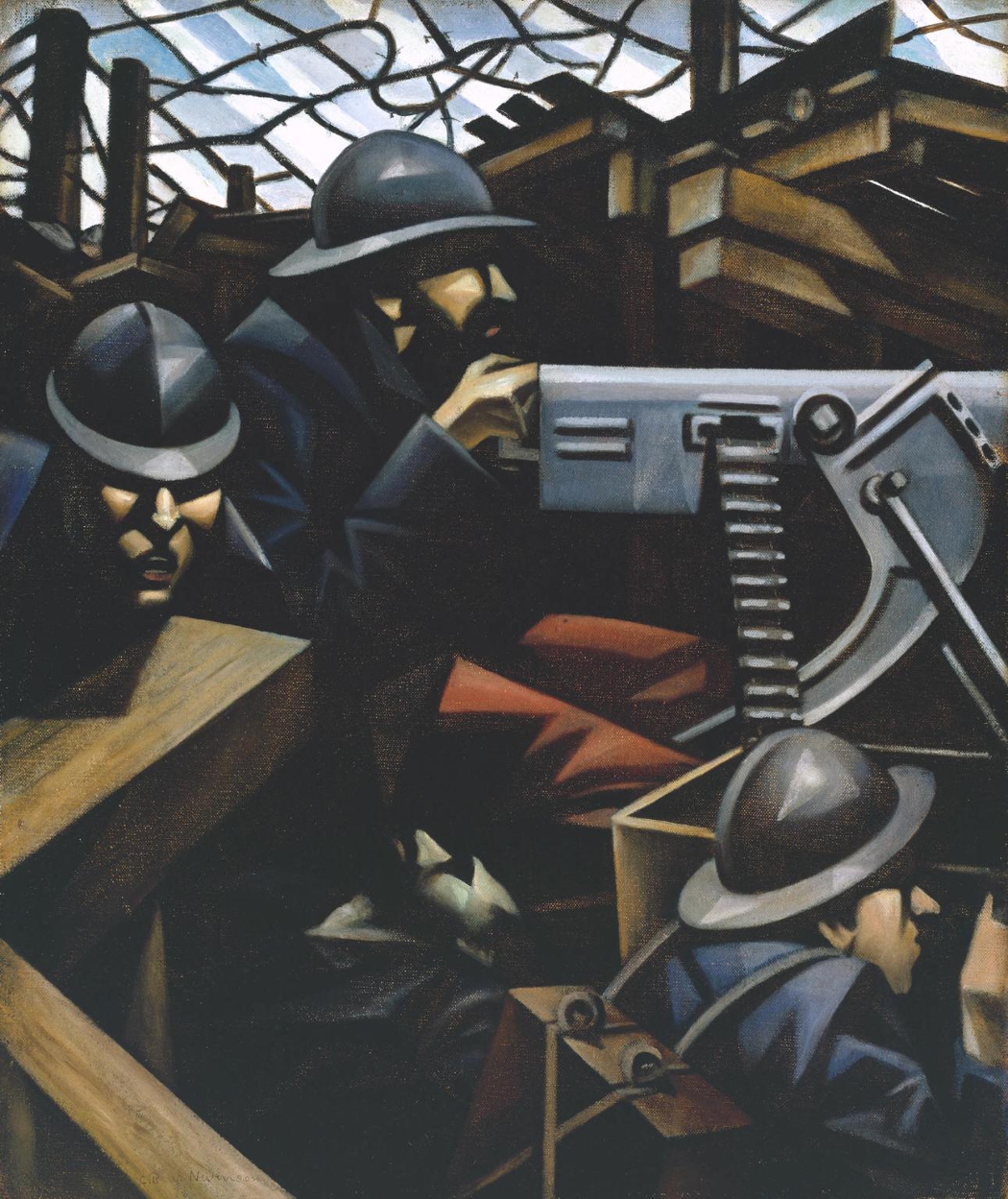
Christopher Richard Wynne Nevinson was one of the First World War’s most illustrious artists. He was an avant-garde painter whose associations with Filippo Marinetti’s Futurist group were apparent in his vivid depictions of the war at home and abroad. Artist Walter Sickert described this painting as ‘the most authoritative and concentrated utterance on war in the history of painting.’
Homefront
Domestic upheaval provided a rich variety of material for artists. The Government bodies responsible for commissioning art, such as the Ministry of Information, also recognized the need to record the war’s impact at home as well as abroad. Well-documented social trends, such as the increased involvement of women in heavy industry, are recorded alongside lesser known effects of the war.
Assembling Parts by CRW Nevinson (1917)
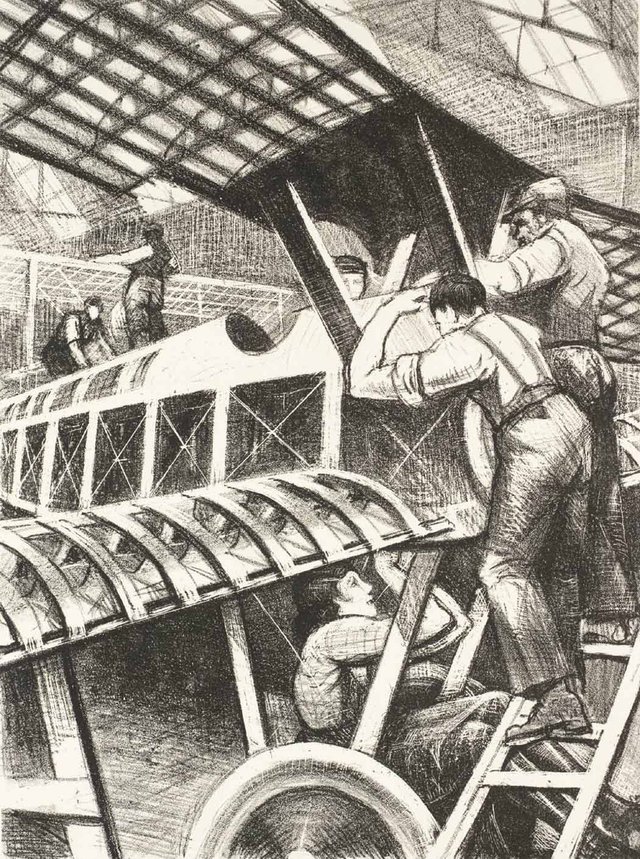
A Canadian War Factory by Percy Wyndham Lewis
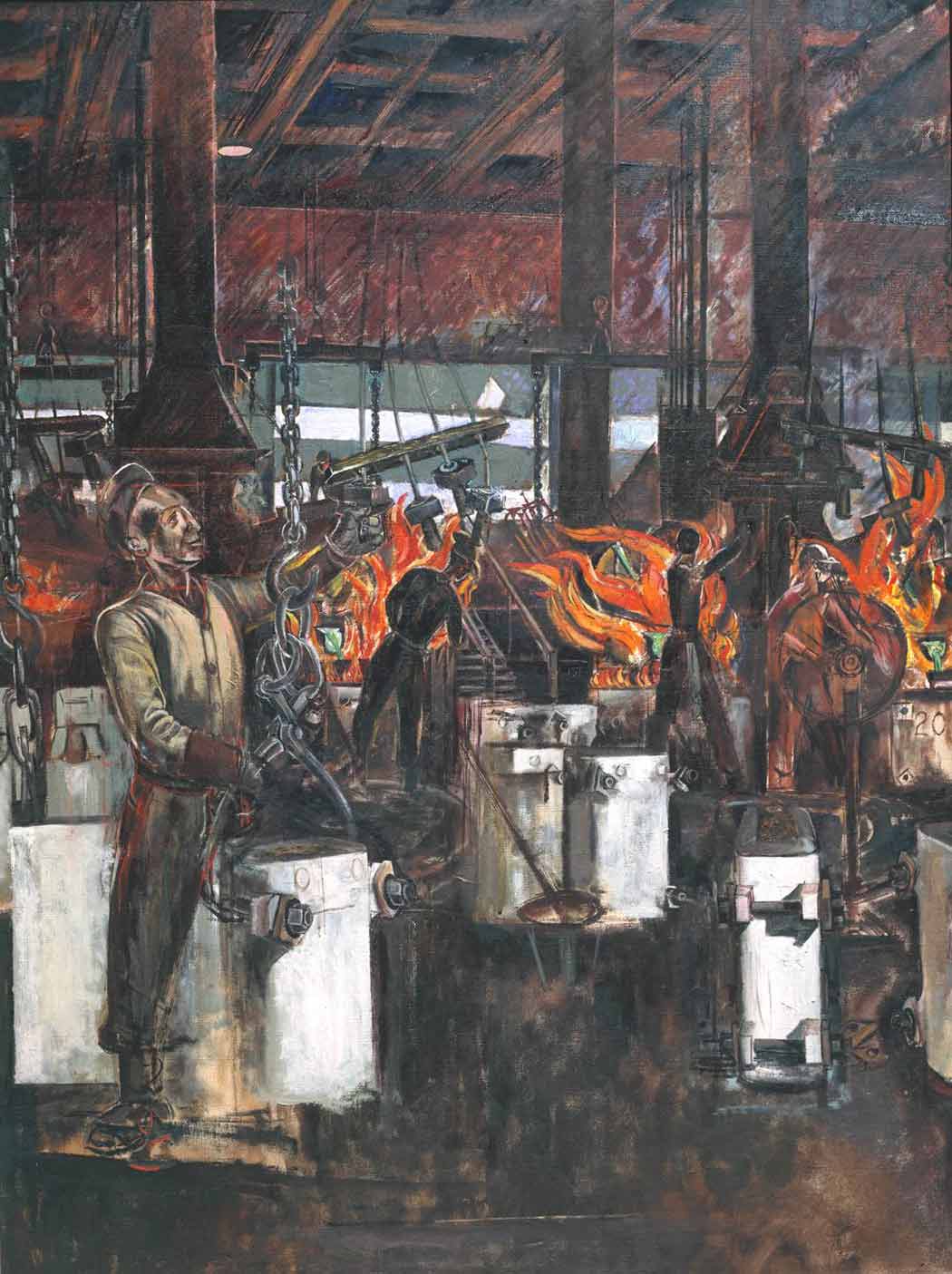
A pioneer of the Vorticism movement, Percy Wyndham Lewis served with the Royal Artillery until 1917 and then as an Official War Artist until the end of the war. His angular, semi-abstract style drew from Cubism and Futurism, and lent itself particularly to striking depictions of machinery in action.
Acetylene Welding by CRW Nevinson (1917)

Swan Upping at Cookham by Stanley Spencer (1915-19)

‘Swan Upping’ is an annual event on the Thames when the swans are marked. Spencer thought the scene melded the everyday with the divine. The completion of this particular work was delayed by Spencer’s involvement in the war.
Making the Engine by CRW Nevinson (1917)
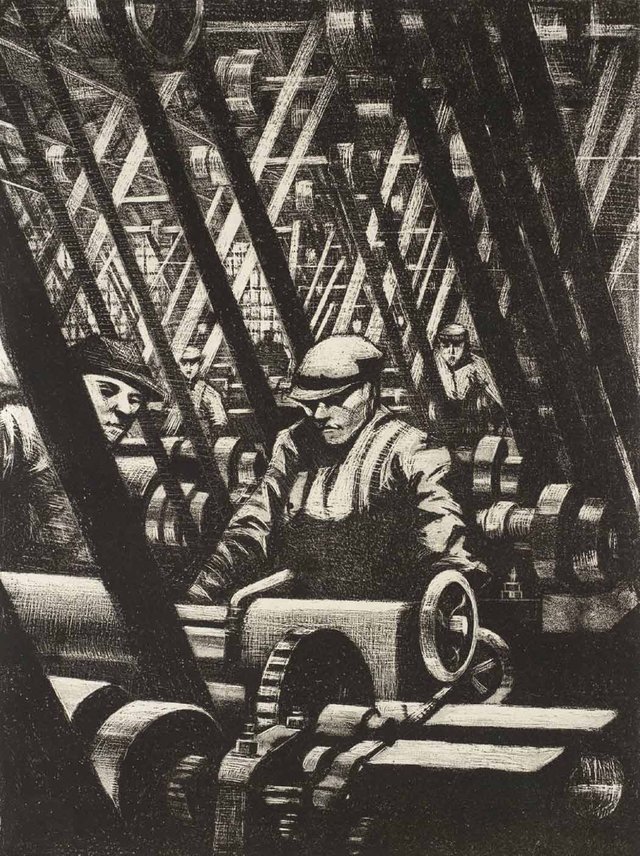
The Frontline
In the early years of the war painters were on the whole willing to participate with sincerity in the enthusiastic culture of war by producing patriotic works. Over time, as the reality of modern, industrialized warfare became apparent, artists attempted to capture the reality of what they were seeing. The heroic realism of earlier works was abandoned, and artists attempted to convey a reality that is beyond the scope of most people’s experience by turning to surreal styles.
A Star Shell (Left, 1916) and Bursting Shell (Right, 1915) CRW Nevinson
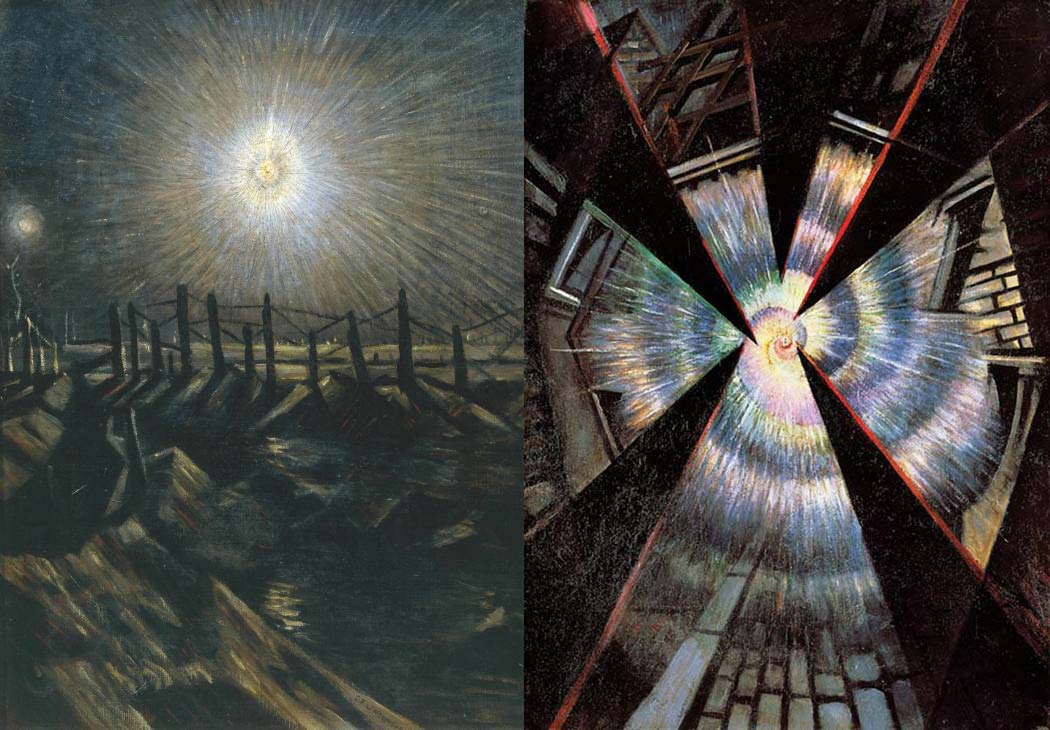
Harvest Of Battle by Christopher Nevinson (1918)
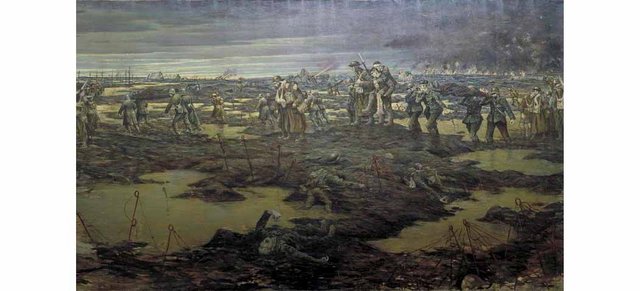
Possibly the most captivating feature of World War One was the devastation wrought by new weaponry. Nevinson described the scene on which this painting was based: ‘A typical scene after an offensive at dawn. Walking wounded, prisoners and stretcher bearers are making their way to the rear through the water-logged country of Flanders.’ The painting was commissioned by the Ministry of Information for the hall of Remembrance. Notably soldiers of opposing forces are shown struggling through the devastation together.
La Guerre By Marcel Gromaire (1925)
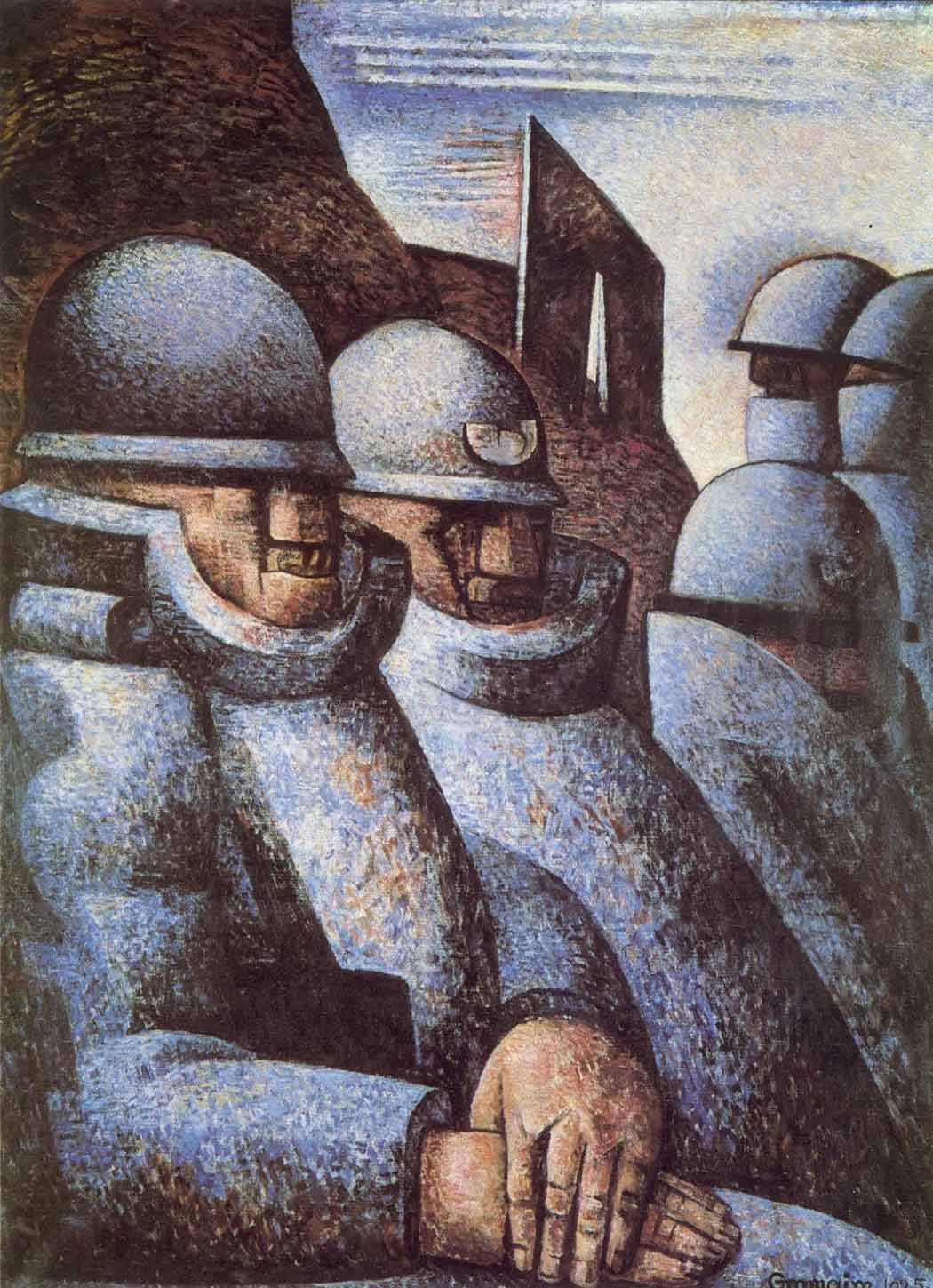
Gromaire’s most famous piece shows five soldiers – three awaiting the assault and two scanning No Man’s land. It was painted seven years after the war ended, and in its rigid style emphasises the mechanization and dehumanization of the war.
Cavalry and Tanks at Arras by Lieutenant Alfred Bastien (1918)
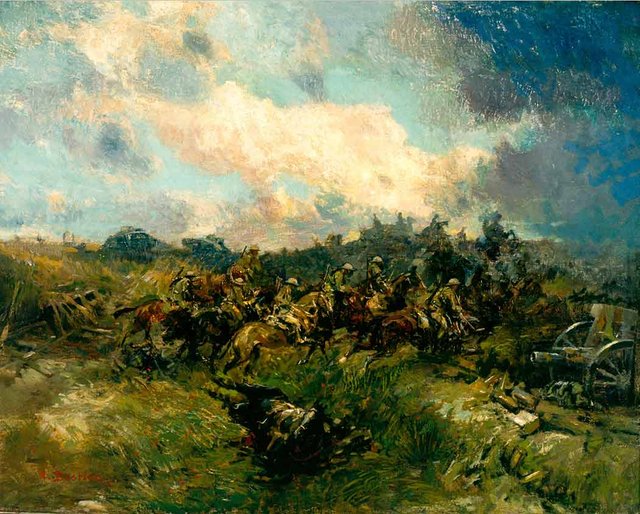
In July and August 1918 Lieutenant Bastin was attached as an artist to the Canadian 22nd Battalion.
Reliefs at Dawn by CRW Nevinson (1917)
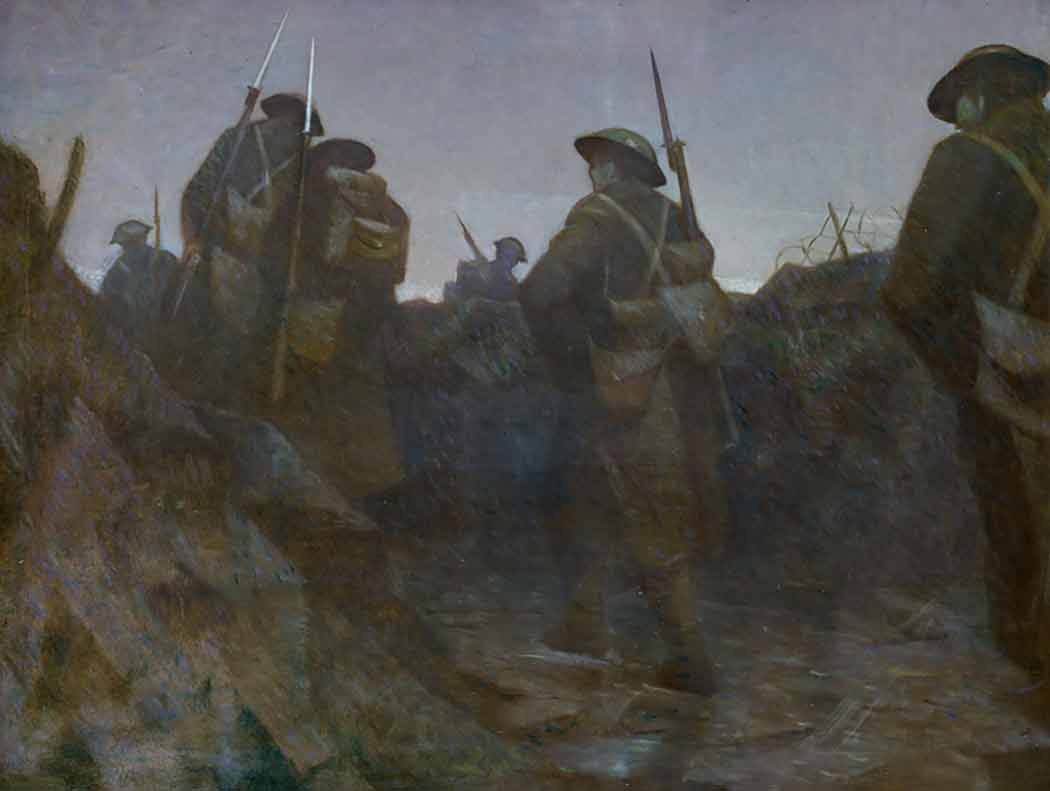
Making Soldiers in the Trenches by Eric Kennington (1917)
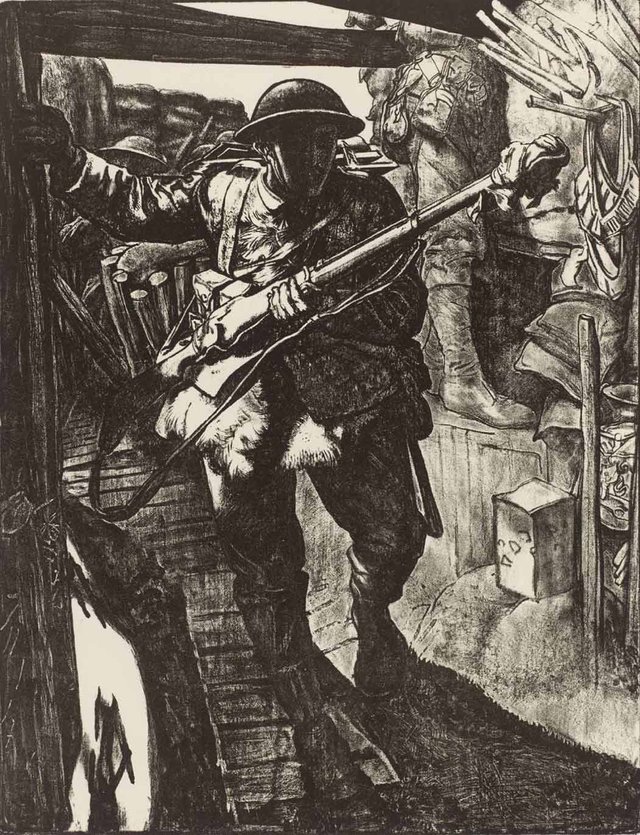
Eric Kennington was invalided out of the Army in 1915 but stayed on as a war artist, tracing the evolution of the war toward hopeless stalemate.
Over The Top by John Nash (1918)
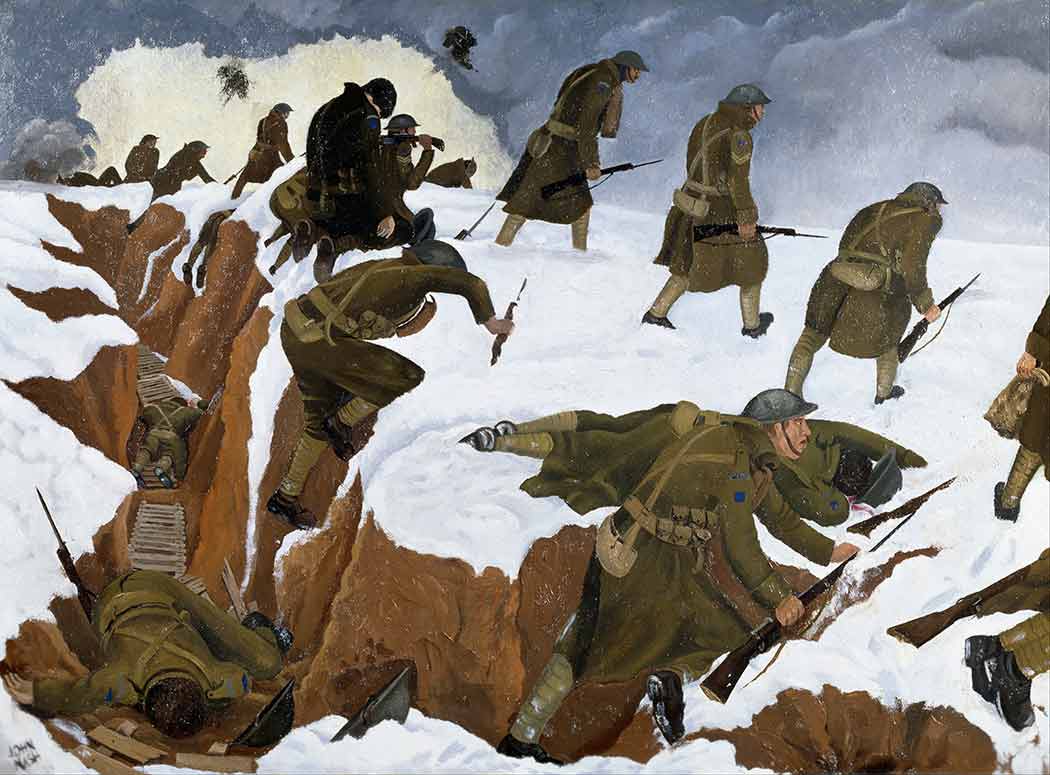
Nash’s most famous painting which shows the 1st Battalion Artists’ Rifles’ counterattack at Welsh Ride on 30 December 1917. 67 out of 80 men were killed or wounded almost immediately.
Evening, After A Push by Colin Gill (1919)
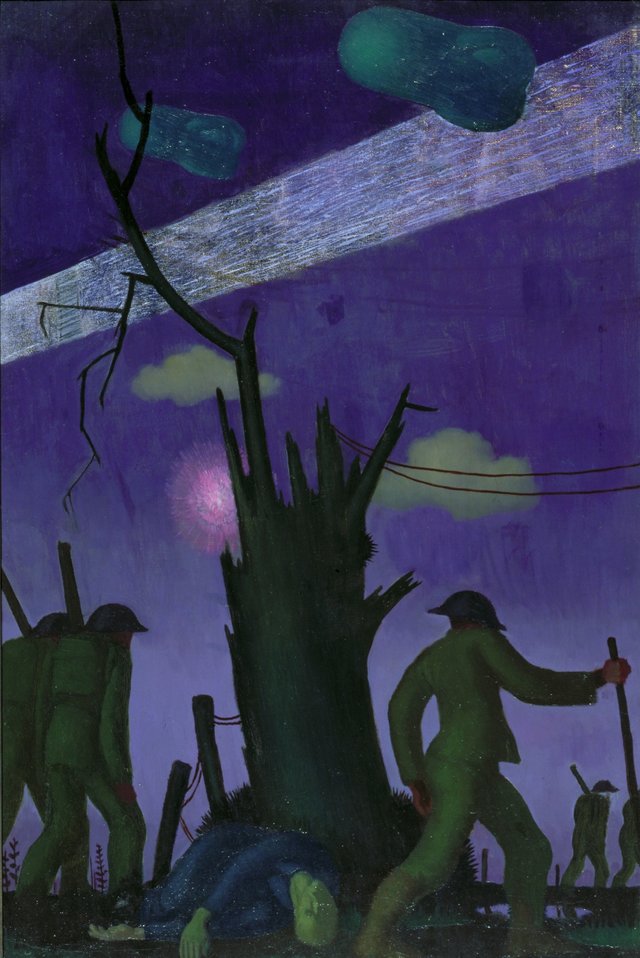
Tanks by William Orpen (1917)
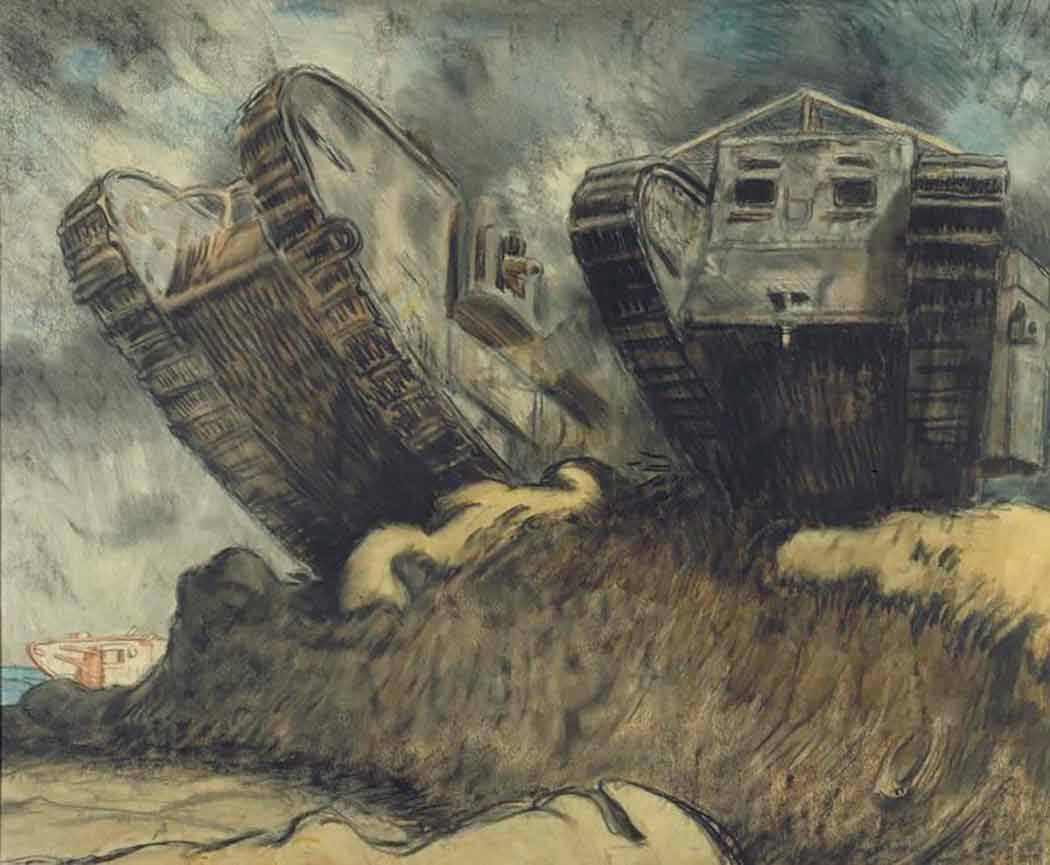
A Mark V Tank Going Into Action by William Bernard Adenney (1918)

The Front Line At Night by JA Churchman
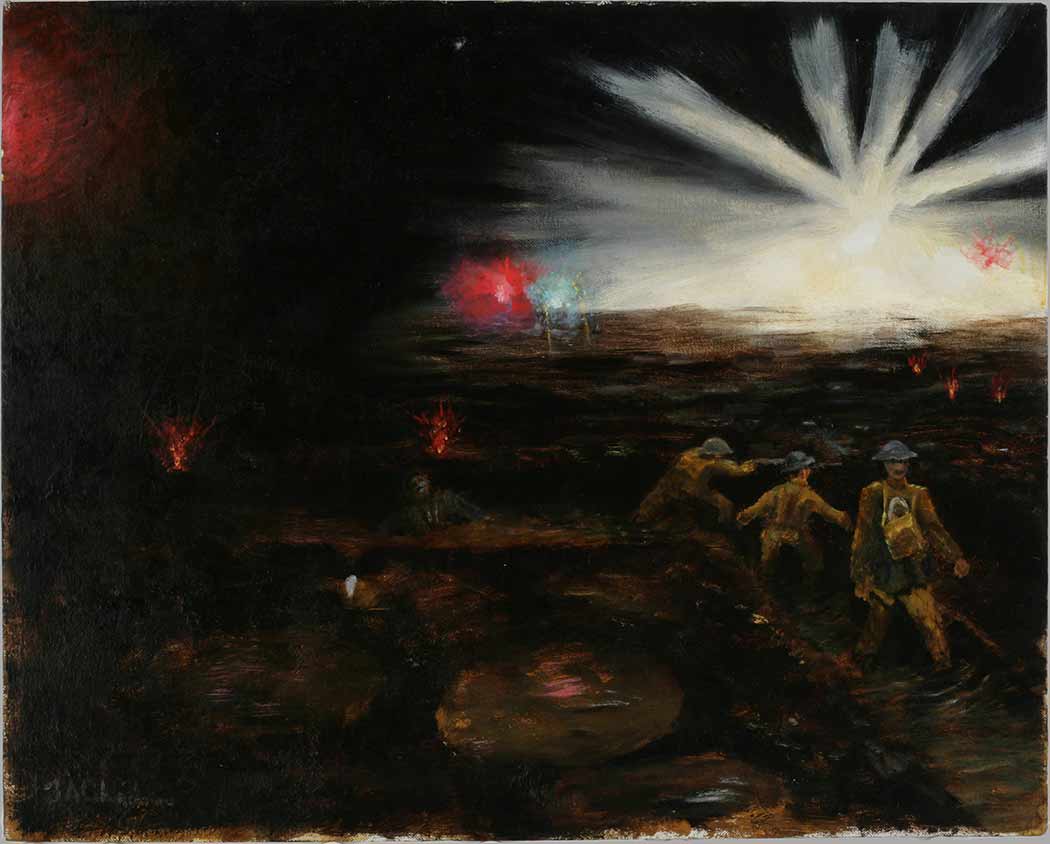
The Ypres Salient at Night by Paul Nash (1918)

This canvas was intended by Nash to capture to disorientating effect that the light emitted by the perpetual explosions of shells and flares had when trying to navigate the trench network.
The Injured and Dead
Gassed by John Singer Sargent (1919)
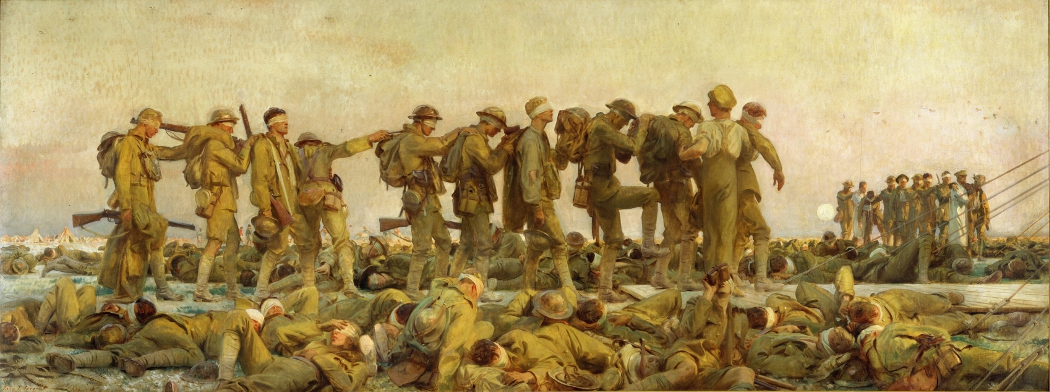
This painting depicts the aftermath of a mustard gas attack witnessed by the artist. Two groups of eleven soldiers are approaching a dressing station against the backdrop of a setting sun.
Gassed and Wounded by Eric Kennington (1918)
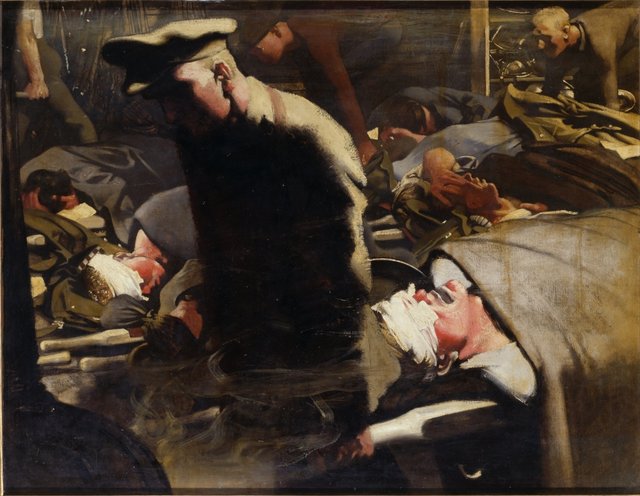
Kennington made several sketches and drawings at a Casualty Clearing Station at Tincourt-Boucly during the pre-Spring Offensive bombardment by German forces. Those drawings provided the basis for this painting.
Travoys Arriving with Wounded at a Dressing-Station at Smol, Macedonia by Stanley Spencer (1919)
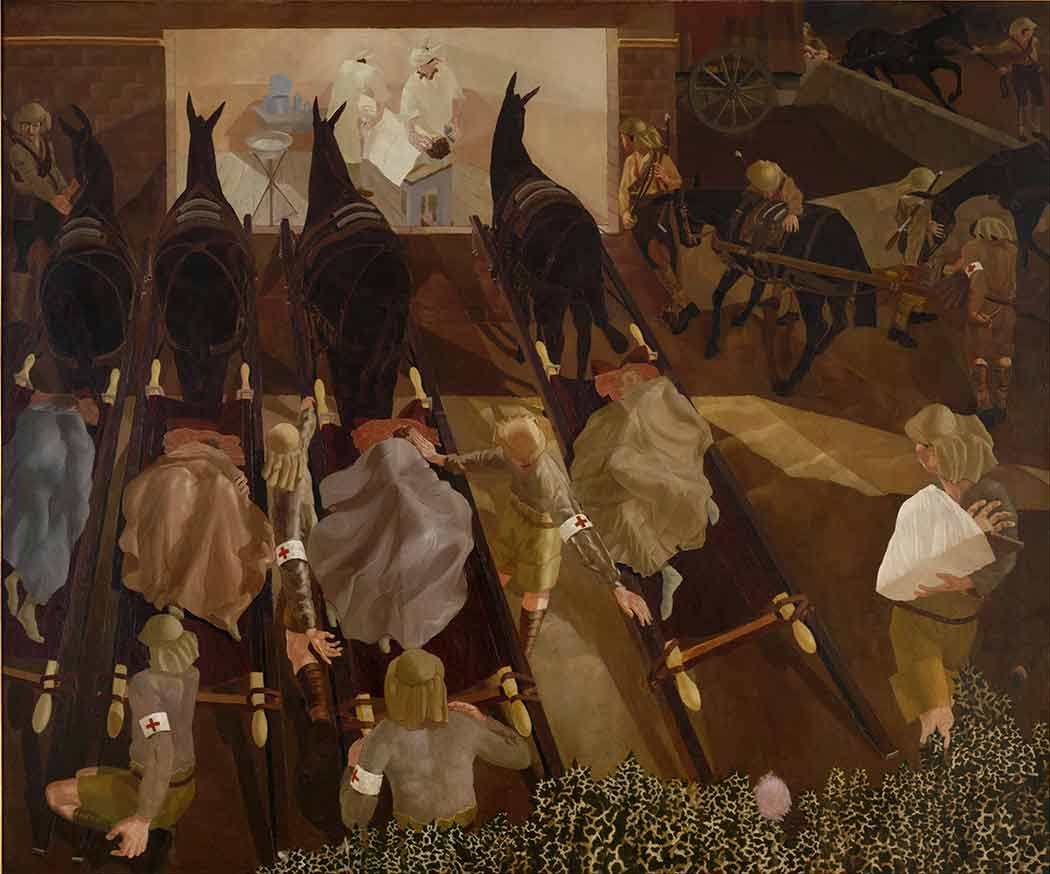
Spencer was commissioned to create this painting in April 1918 by the British War Memorials Committee. In his owns words Spencer wanted to show ‘God in the bare real things, in a limber wagon, in ravines, in fouling mule lines.’ Of those he depicts he said ‘during these nights the wounded passed through the dressing stations in a never ending stream.’
The Queen’s Hospital For Facial injuries by Lobley J Hodgson (1918)
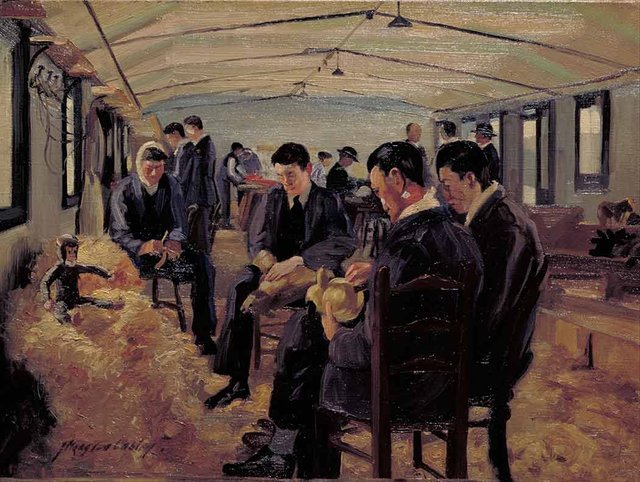
Paths of Glory by CRW Nevinson (1917)
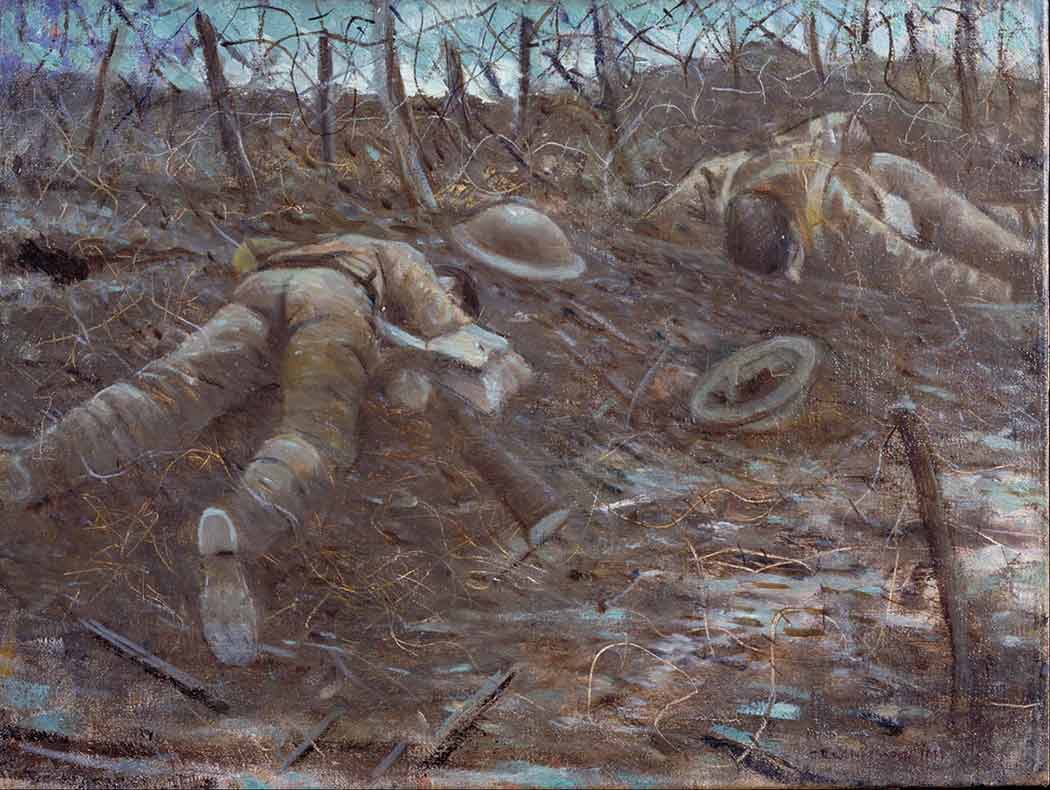
Resurrection of the Soldiers by Stanley Spencer (1929)
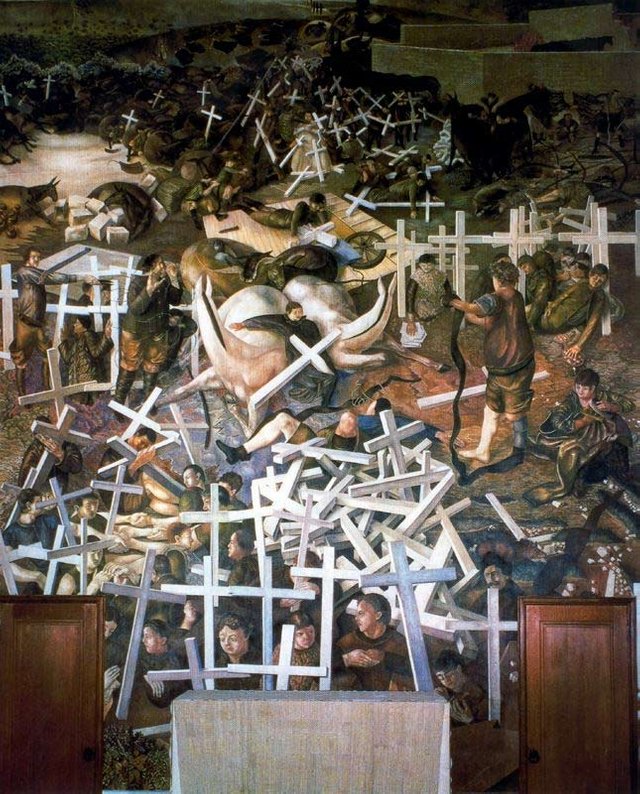
The painting re-imagines the battleground of the Karasulu-Kalinova sector of the Macedonia front in 1917 and 1918 through a re-working of medieval and Renaissance versions of The Last Judgment. Its intended functions are mixed given the variety of events within this one scene.
German Perspective
The trends described thus far applied also to German artists. They too were confronted with an unanticipated and shocking type of war which they sought to represent is a variety of ways.
Self-Portrait as a soldier by Otto Dix
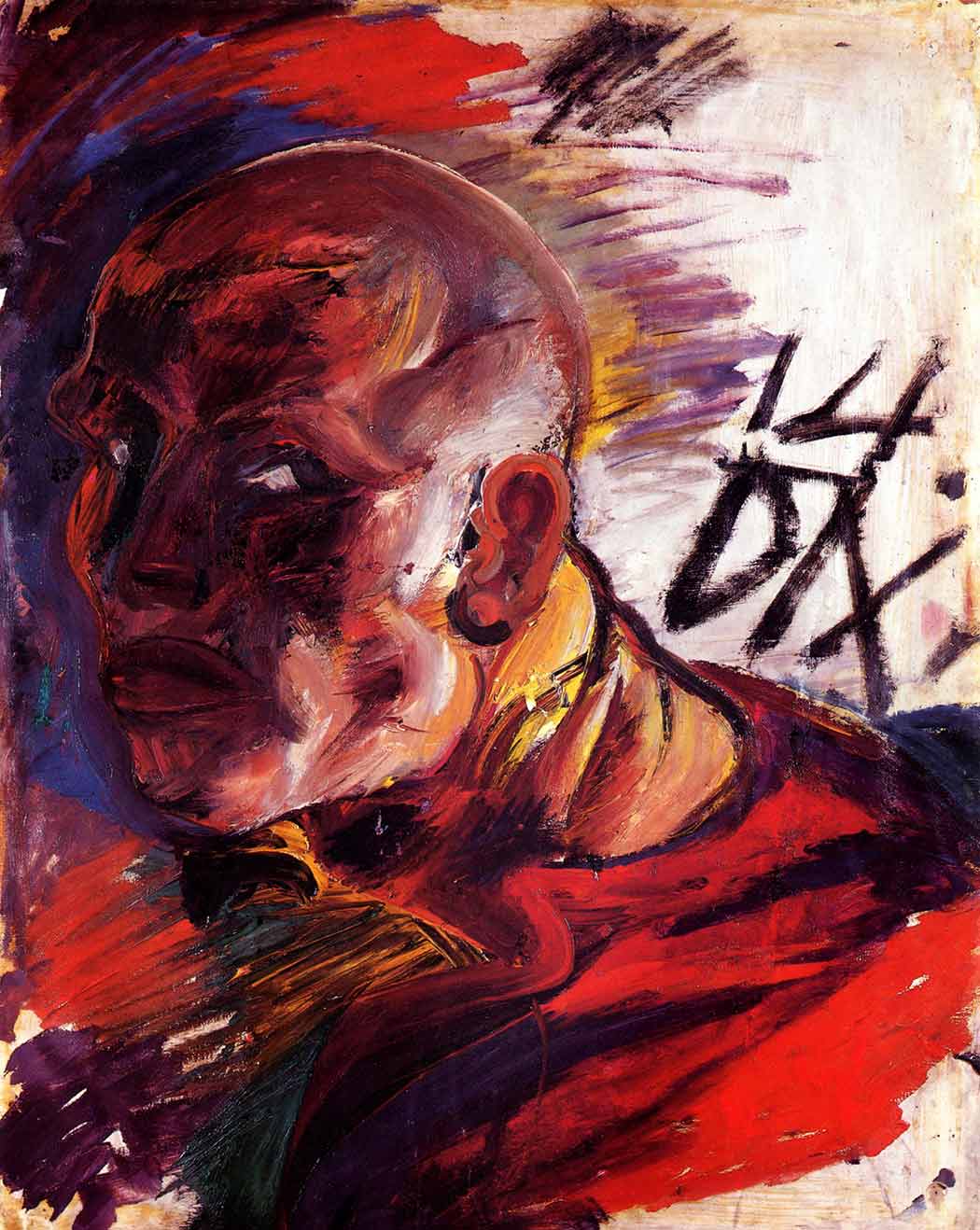
Wilhelm Otto Dix was renowned for his brutal and harshly realistic style. His work embodies a transition in the style of First World War Art that mirrored the erosion of hope and the triumph of stagnant, bleak, bloody warfare.
Stormtroopers Advancing Under Gas by Otto Dix (1924)
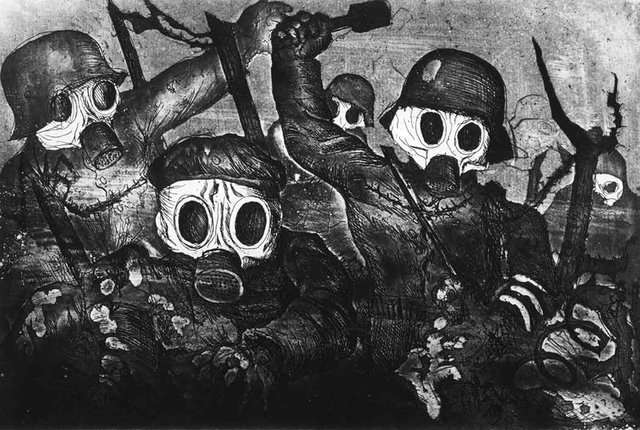
This is the most reproduced print from Der Krieg, Dix’s uncompromisingly harsh fifty plate series on the horrors of trench warfare. Notice that soldier on the far left is snared in barbed wire.
Den Namenlosen by Albin Egger-Lienz (1925)
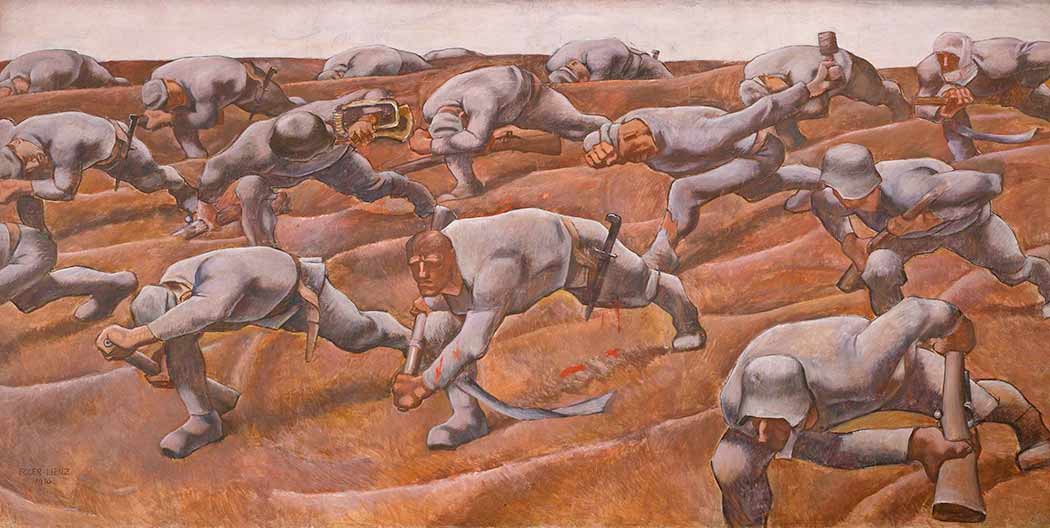
Machine Gunners Advancing by Otto Dix (Left) and Corpse In Barbed Wire (Right) by Otto Dix (1924)
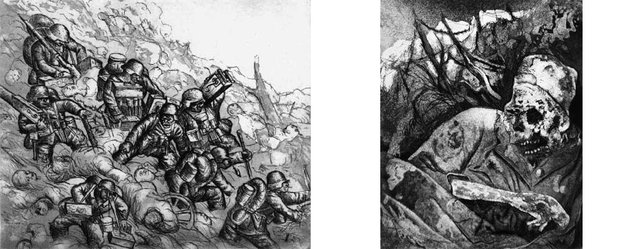
Another plate from the Der Krieg series that doesn’t hold back when it comes to capturing the dark, morbid reality of trench warfare.
The Shattered Landscape
Given many of the war’s most prominent artists were landscape artist (like Paul Nash) perhaps most iconic work depicted its desolate aftermath. The topographical scars of war were profound and many artists claimed it was those which best encapsulated an unprecedented tragedy.
Ypres Salient at Dawn by Edward Handley-Read (1915)
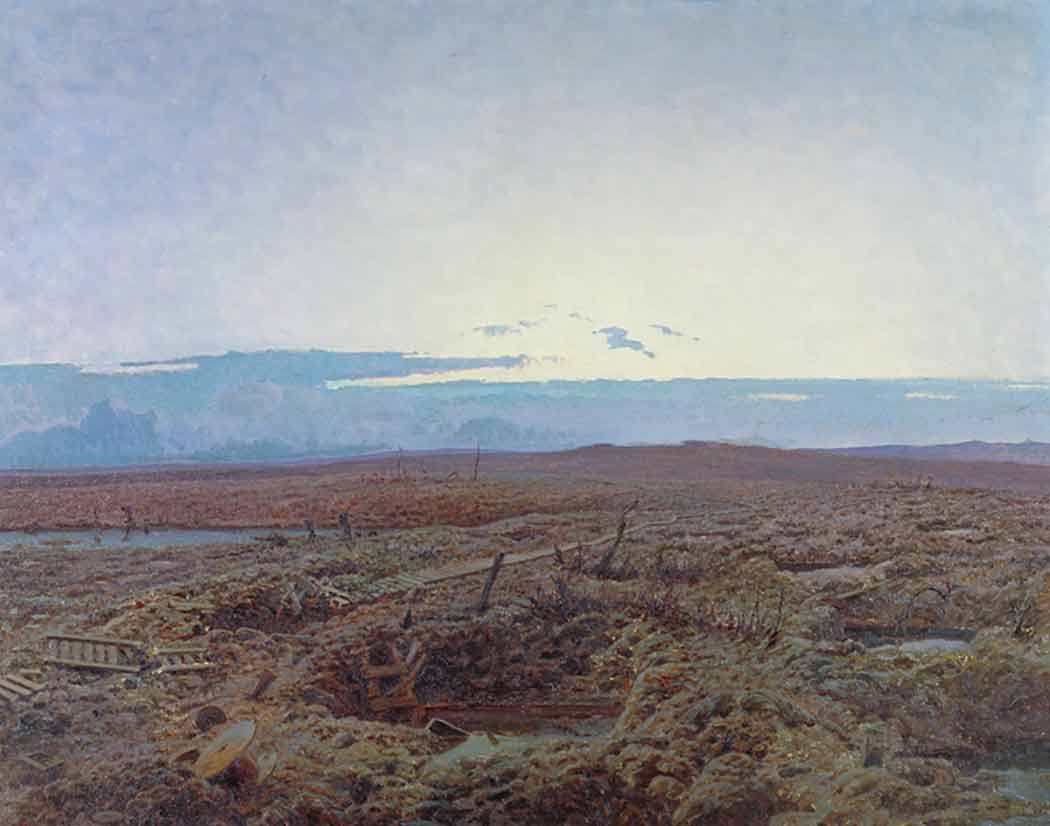
Oppy Wood by John Nash (1917)

With his brother Paul, John Nash served as an infantryman in the Artist’s Rifles. He was not formally trained as an artist and only became a war artist in 1918. He became known for his carefully-detailed illustrations of trench life.
House of Ypres by AY Jackson (1917)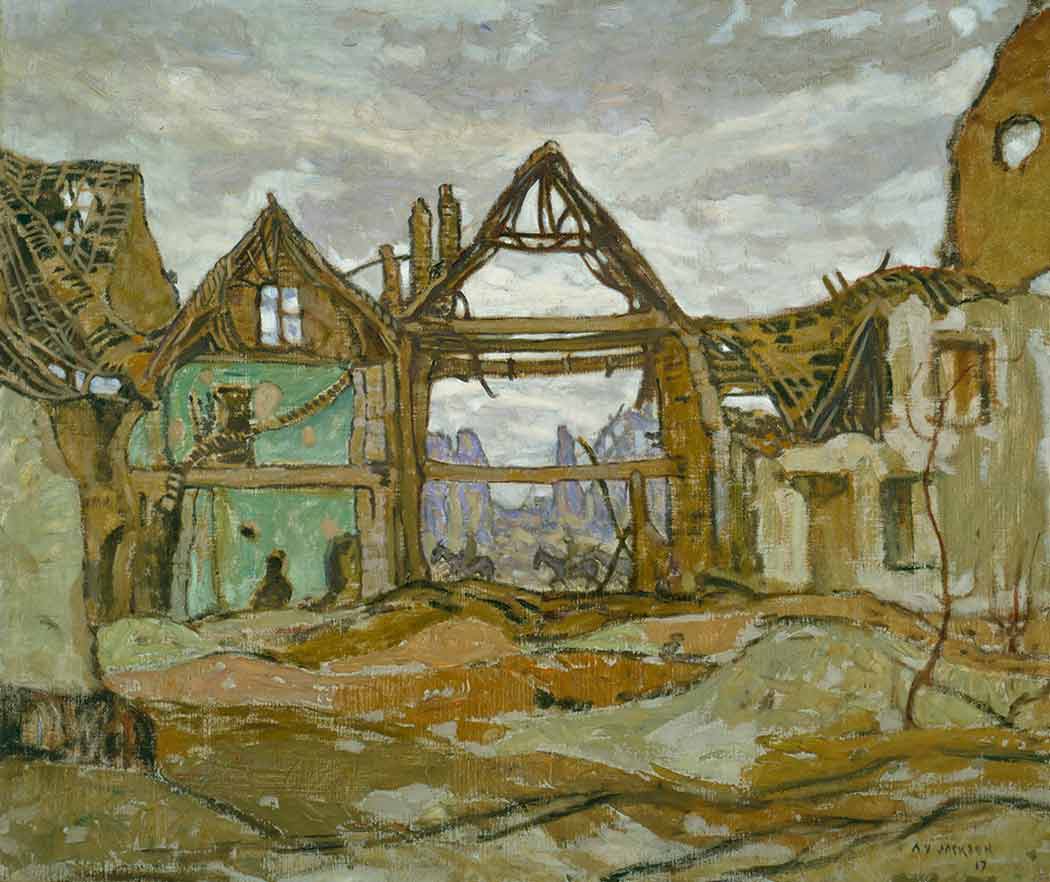
Zonnebeke by William Orpen (1918)
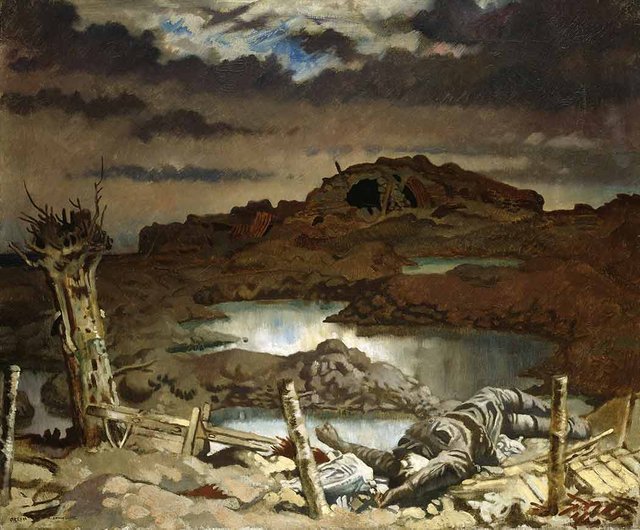
Night Bombardment by Paul Nash (1918-1919)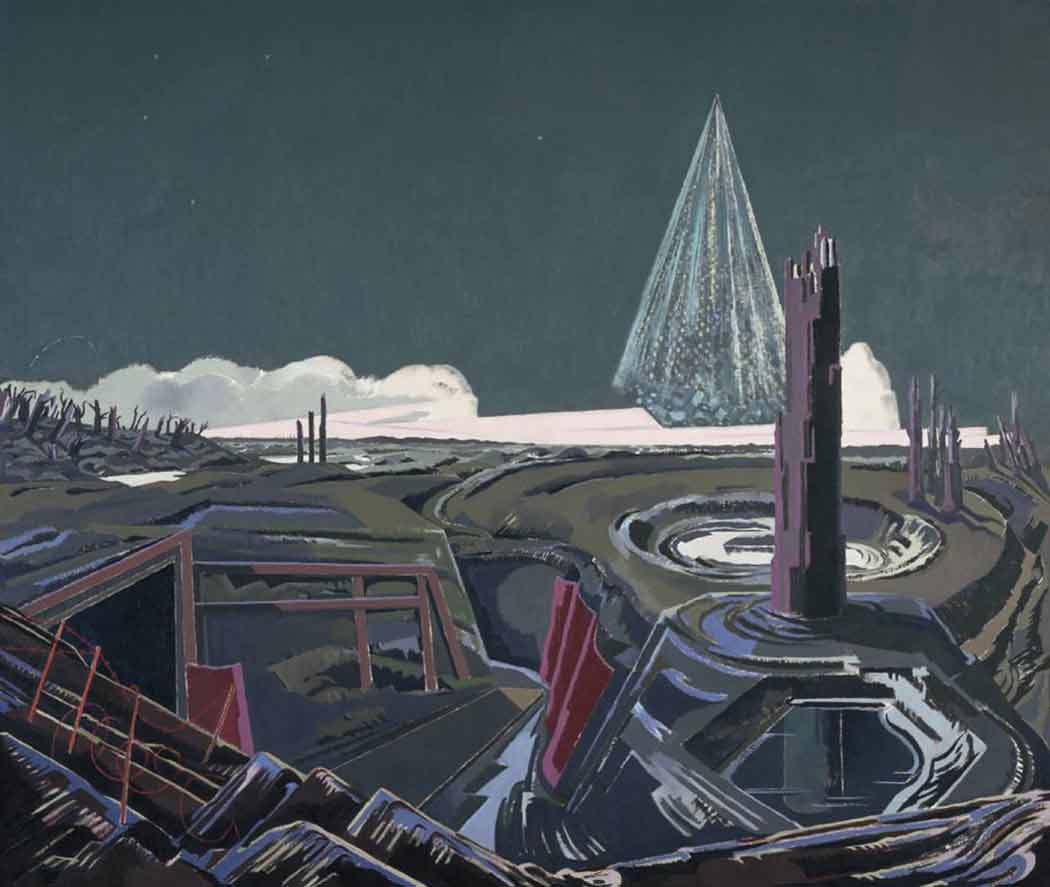
This work is reminiscent of early Nevinson work, with its emphasis on combing figurative elements -tree trunks, barbed wire – with geometrical elements, both curved and angular.
The Road From Arras to Bapaume by CRW Nevinson (1917)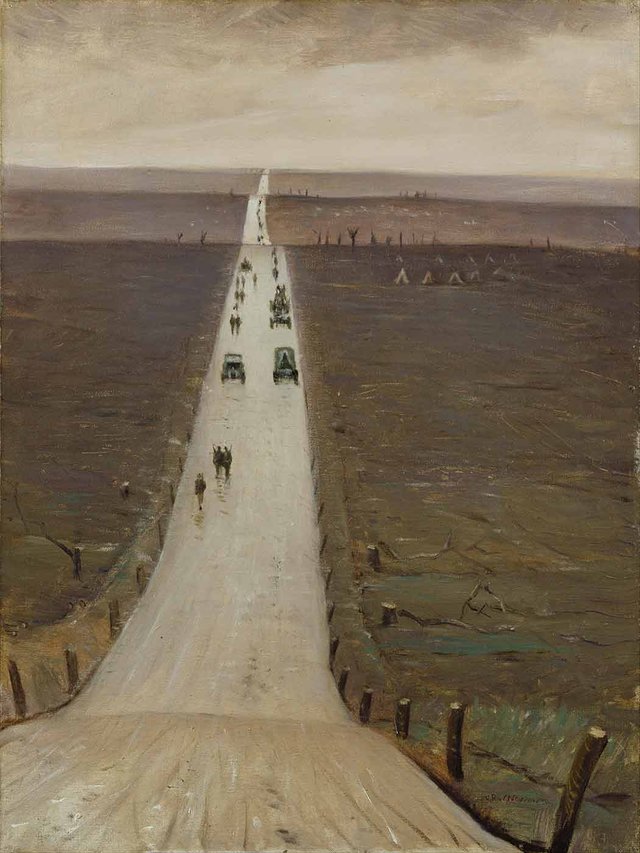
The long road from Arras to Bapaume undulates into the distance. This stark, empty scene of desolation shows the real impact of modern warfare.
Wire by Paul Nash (1918)
The Conquerors by Eric Kennington (1920)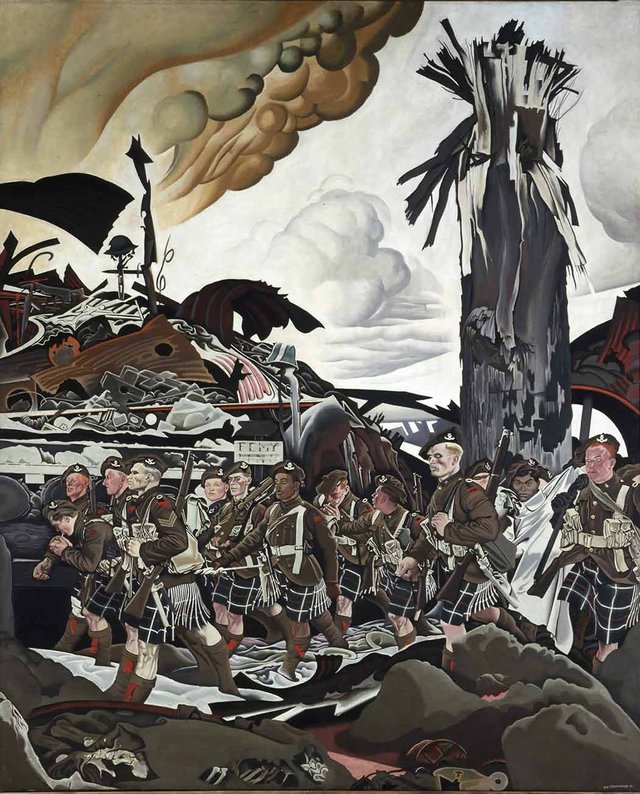
Void of War by Paul Nash (1918)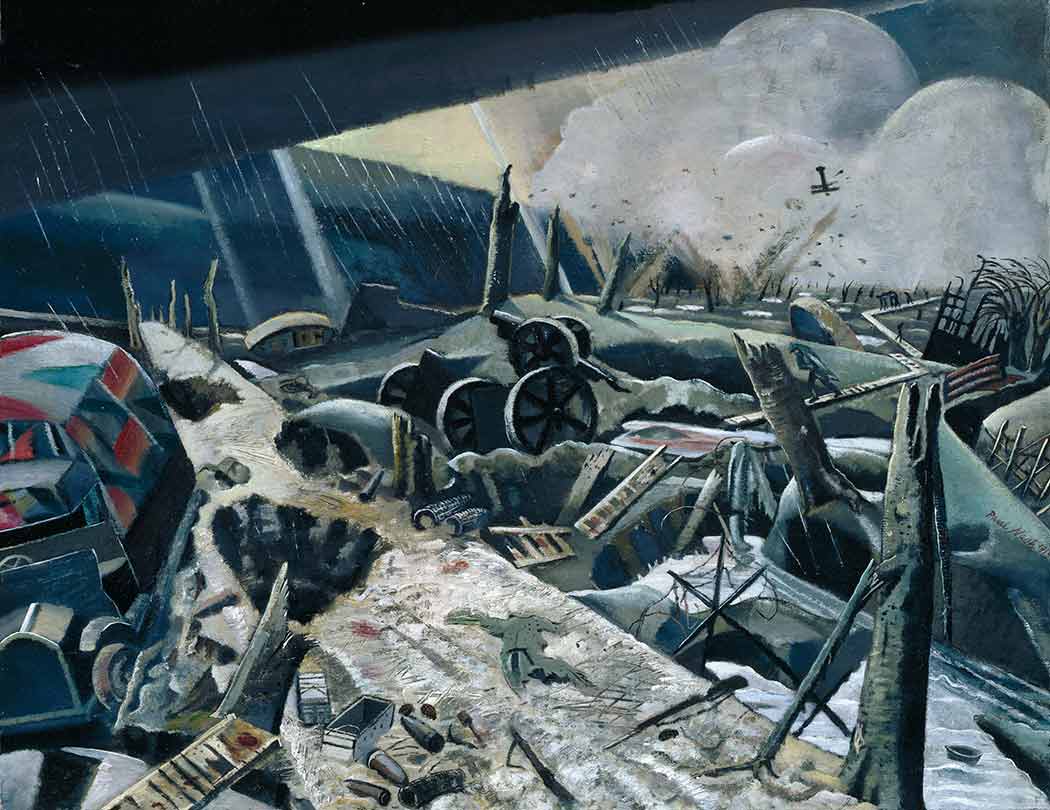
Warrington Road by Richard Tennant Cooper (1917)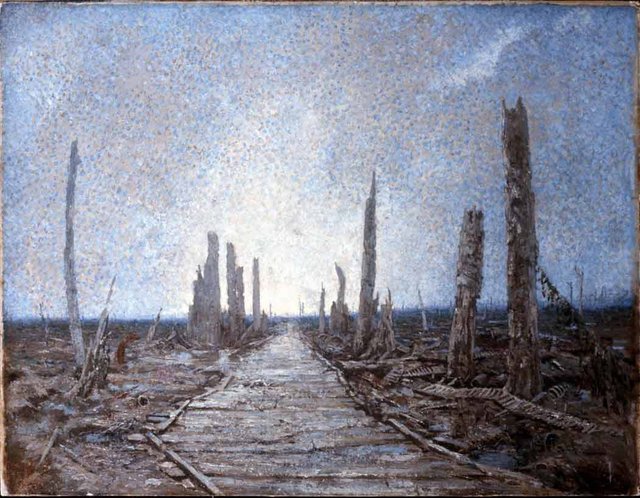
We Are Making a New World by Paul Nash (1918)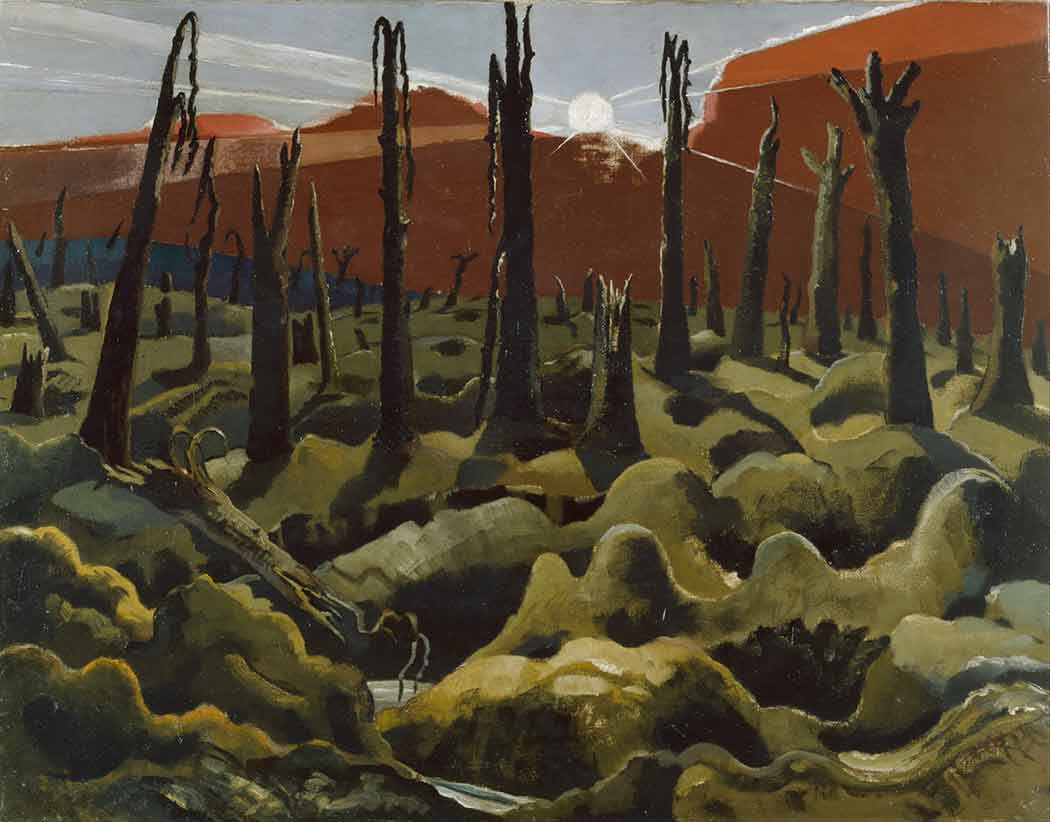
One of the most memorable images of the war, the title ‘We Are Making A New World’ mocks the ambitions of the war’s early leaders. It expresses the idea that a new world has been created through this distorted landscape. It has been claimed that the undulations in the earth represent gravestones to a recently departed world.
Aftermath
It was not only the battlefields of France and Belgium that were ravaged by the war. German artists operating in the new Weimar Republic painted scenes of destitute ex-soldiers interacting with a strange modern society.
The War Cripples by Otto Dix (1920)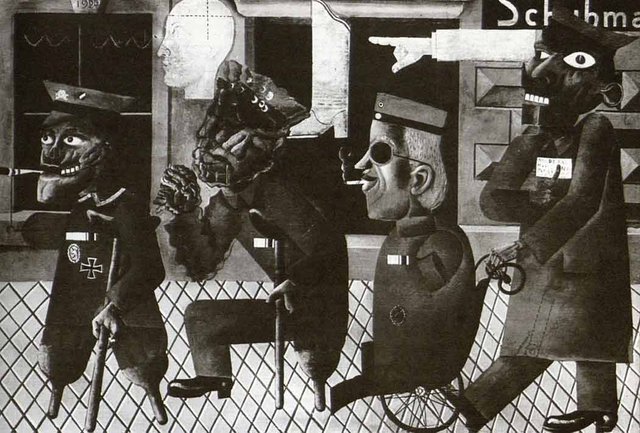
Tempo Of The Street by George Grosz (1918)
In post war Germany, George Grosz was keen to express the vitality within cities, often mixed with disturbing and grotesque elements.
The Night by Max Beckman (1918-19)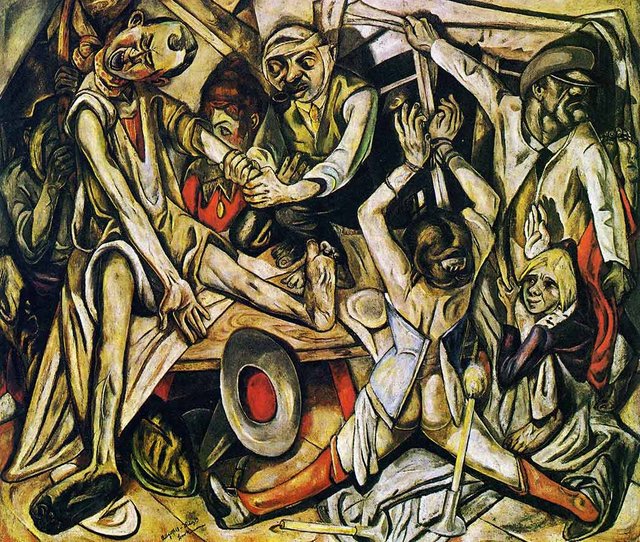
The Signing of Peace in the Hall of Mirrors, Versailles, 28th June 1919 by Sir William Orpen (1919)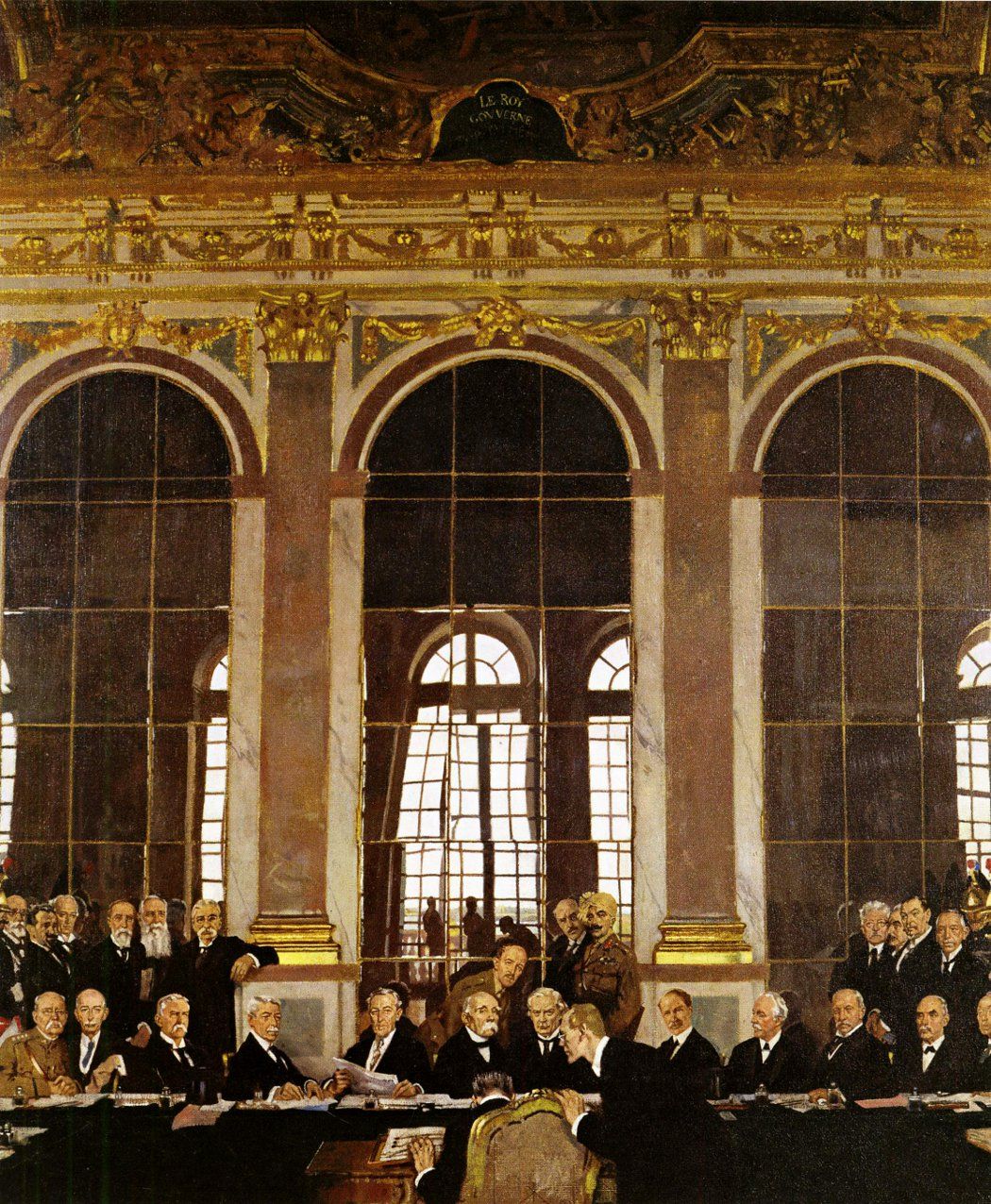
The Treaty of Versailles was the agreed peace and its settlement was the end of the war. But etched in the faces of those throughout the hall of mirrors is the uncertain peace that the treaty would bring.
Many of these works are available to view at Truth and Memory British Art of the First World War at the Imperial War Museum London.
This is my one of the best rare collection I have ever done.
Please Support me by voting.. I will upload more historical blogs with art photo.